6 Ways to Optimize or Reduce Memory Usage for Running Programs
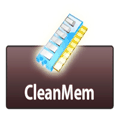
One of the biggest upgrades you can make to an older computer is being sure it has enough memory (RAM) to handle the operating system and all the programs you want to run on it. When Windows starts to run out of physical memory it offloads data to the page file which is stored on your hard drive. As we know, a hard drive is much slower than RAM and this is why a system with a low amount of memory can start to slow down really quickly with several programs running at once, or a web browser with many tabs open, for example.
It’s not always possible to put more memory into an aging computer simply due to high costs for old types of RAM or a lack of RAM slots, such as in a laptop or netbook. Thankfully there are ways to get around this issue through software which is able to reduce the amount of memory a system process consumes by using a documented feature in the Windows API. This gives a program the memory it actually needs and not what it asks for, reducing the amount of used memory while not impacting on the performance of your computer
Here we show you 6 free tools that can help reduce the memory your system is using and keep it running more smoothly for longer.
1. Wise Memory Optimizer
WiseCleaner make a number of useful utilities for a wide range of tasks, one of their more recent creations is Memory Optimizer. This program is very easy to use with a clean interface and has only half a dozen options to setup the way you want, so you can’t really make many mistakes or cause the computer to run worse.
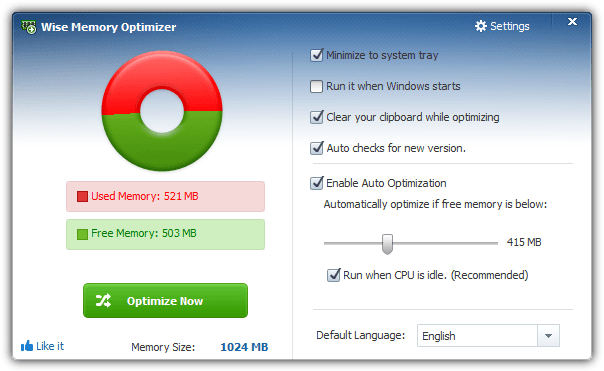
On launch the options aren’t visible and you can just see the memory real time usage graphic and Optimize button, press Settings to expand the window. Then you can decide when to run Memory Optimizer, whether to clear the clipboard when optimizing and enable the Auto Optimization function. This will start the memory optimization when the amount of RAM available hits the number set by the slider. Wise Memory Optimizer is portable and light too, only using around 2MB of memory while sitting in the system tray.
Download Wise Memory Optimizer
2. Rizonesoft Memory Booster
Previously called Datum Memory Booster, this is another program that uses Windows API calls to reduce the amount of working memory reserved by a process. Like the Wise utility above, Memory Booster is portable and easy to use and also impressively uses no more than a Megabyte of memory while sitting in the system tray or while optimizing.
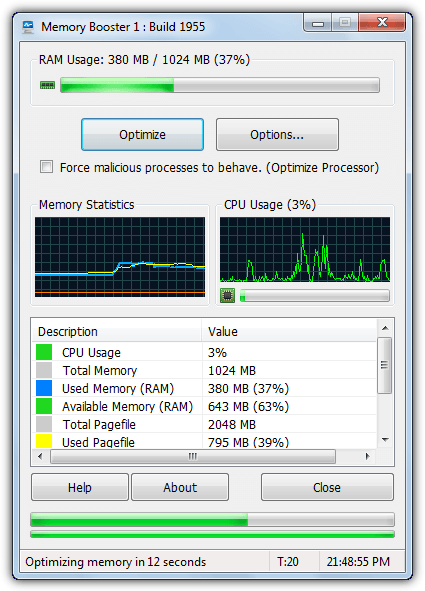
The main window offers a good amount of information about how much memory is in use, how much of the pagefile is in use and the amount of virtual memory the system is using. There’s also a few useful graphs to show these memory values live and the current CPU usage. The program starts in “Intelligent Memory Optimization” mode which will run at an interval decided by Memory Booster, it was 20-25 seconds during testing. You can however, set this value yourself or turn it off altogether and run optimizations manually.
Download Rizone Memory Booster
3. RAMRush
RAMRush is almost as simple as it gets in terms of difficulty to use, the only real choices you have to make are whether you want start the program with Windows, whether you want tray icon messages, what hotkey combination to use and what colors you want the graphs to be.
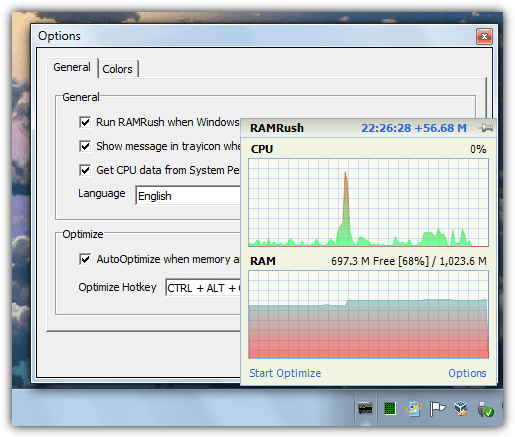
There is a difference between RAMRush and other tools because it doesn’t offer to auto optimize the memory and this is done entirely when you choose to run the optimize manually. You can do this either by double clicking on the tray icon, hovering over the tray icon to bring up the CPU and RAM graphs, then click “Start Optimize” or press the hotkey combination (the default is Ctrl+Alt+O). About 2MB of memory is used while RAMRush is in the tray.
4. Minimem
Minimem was originally developed for reducing the memory consumed by Firefox but now its scope has expanded to reduce the memory of any application. It takes a different approach to other memory reducing programs because you actually choose the processes you want Minimem to optimize the memory of, so if you have a couple of applications that take up more memory than they should, Minimem can just keep those under control.
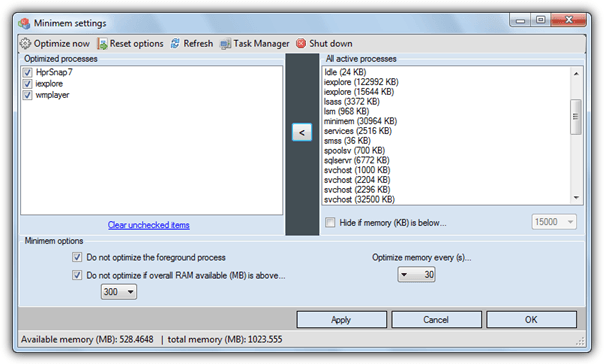
The way it works is a list of high memory usage (or all if you choose) processes will appear in the right pane, then you highlight what you want and click the left arrow to add the process to the optimize list. You then choose from the options below what time interval to run the optimize (5-1200 seconds), whether you want to ignore the program if it’s the foreground process and how much system RAM will be remaining before Minimem goes to work. Minimem’s own memory usage fluctuates between 1Mb and about 10MB.
5. CleanMem
CleanMem is possibly one of the most advanced memory optimizers around while at the same time being easy to use if you don’t require the extra functions. Auto optimization is handled by the Windows Task Scheduler and runs every 15 minutes, this is setup by default on install. If you want to change to a different interval, a basic knowledge of how Task Scheduler works will be needed. The task can be disabled via settings if you don’t want to run a schedule.
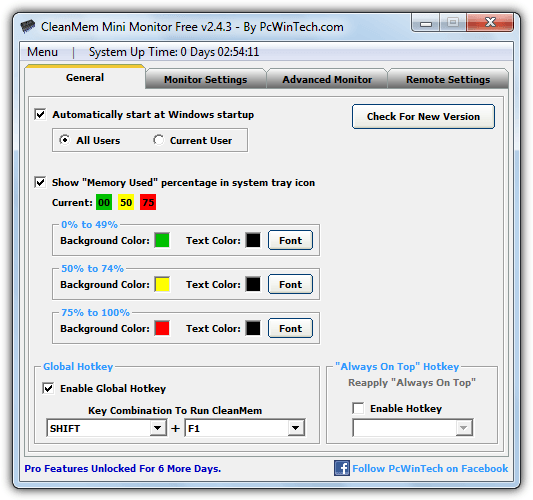
Running as a schedule has a big advantage because the program doesn’t need to constantly run in the background, saving even more memory. A mini monitor is available which can constantly show desktop and tray icon displays of memory usage, several options of the look and feel of these monitors are in the settings window. CleanMem has a portable version but it doesn’t automatically create the scheduled task. A unique feature is the ability to view memory stats and run CleanMem over a network.
Download CleanMem (Installer or portable)
6. Mz RAM Booster
This program is like a mini optimization suite because apart from the memory boosting functions it also has a “System speedUp” tab. You should make sure you have adequate system backups using this tab as it could make things worse if done incorrectly. Tweaks to the CPU priority, process shutdown timeouts, unloading unused DLLs, keeping Windows Kernel in memory and the NTFS file system are available. Some of them might help, others are known to not make any real difference.
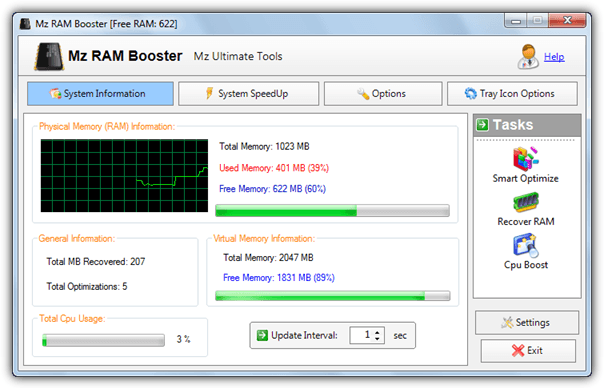
The immediate thing you should do on first launch is go to the Options tab and press “Recommended Values”, this adjusts the amount of memory reclaimed during optimizing. The other settings such as intervals and startup options can be edited afterwards. The “Smart Optimize” task is the standard and recommended method to run manually, “Recover RAM” tries to unload extra DLLs, “CPU Boost” tries to free up idle tasks but could take up to 15 minutes to do it. Mz RAM Booster is light consuming around 1MB while in the system tray.
Note: These tools were tested on windows 7 as we didn’t feel it really necessary to try them on Windows 8. If you’re running Windows 8/8.1, it’s quite likely your computer is no more than a few of years old and will likely have 2GB/4GB of memory at the very least, making tools like these less useful. Wise Memory Optimizer, Rizonesoft Memory Booster and CleanMem are officially listed as Windows 8 compatible if you still wish to try and optimize your memory.
If your system has a good amount of memory such as 4GB+ anyway, a tool like this isn’t really needed unless you constantly run software which has issues with memory leaks.
In conclusion, using these 6 free memory optimization tools can help reduce memory usage and improve the performance of older systems. If you’re looking for additional ways to speed up your computer, check out this list of RAM disk software for faster read and write speeds.





User forum
27 messages